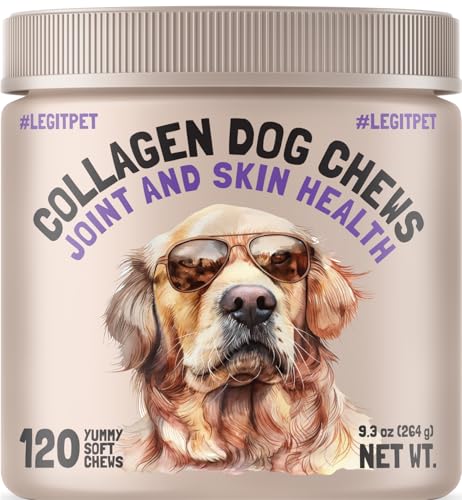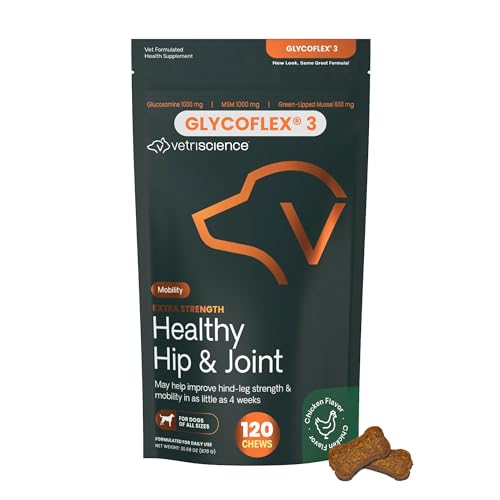7 Essential Dog Joint Supplements Your Vet Doesn’t Want You to Miss

Everything You Need to Know About Dog Joint Supplements: A Complete Guide

Our four-legged best friends work their joints overtime throughout their lives. Whether you’ve got a young pup who thinks he’s an Olympic athlete or a senior citizen who’s moving a bit slower these days, understanding dog joint supplements can significantly improve your pet’s quality of life. Let’s explore how to keep your pooch moving and grooving for years to come!
What Are Dog Joint Supplements?

Dog joint supplements support and maintain healthy joint function in our canine companions. Unlike medications that target symptoms, these supplements act as maintenance, quietly nourishing and protecting your dog’s joint structures daily.
Think of them as providing the building blocks for your dog’s internal maintenance team. They help slow down the natural wear-and-tear process on joints and cartilage. While they aren’t miracle solutions that will have your aging dog doing backflips, quality joint supplements can be a valuable component in maintaining your dog’s mobility and comfort.
Signs Your Dog May Need Joint Support

Since our dogs can’t tell us when they’re experiencing discomfort, we need to watch for behavioral clues. Here are key signs your furry friend might benefit from joint support:
- Reluctance to climb stairs or jump onto furniture
- Morning stiffness that improves with movement
- Decreased interest in walks or play sessions
- Occasional limping or favoring a leg
- Visible joint swelling
- Difficulty rising from a lying position
- Sensitivity or pain when certain areas are touched
- Excessive licking or chewing at specific joints
These changes often develop gradually, making them easy to miss or attribute to normal aging. Recognizing these signs early and starting appropriate supplements can often make a significant difference in maintaining your dog’s mobility and quality of life.
Key Ingredients in Effective Joint Supplements

Understanding the major components in joint supplements helps you make informed choices for your pet. Here are the most beneficial ingredients to look for:
- Glucosamine: Supports cartilage production and repair
- Chondroitin: Prevents cartilage breakdown and maintains joint fluid viscosity
- MSM (Methylsulfonylmethane): Provides sulfur for joint health with anti-inflammatory properties
- Omega-3 fatty acids: Reduce inflammation throughout the body
- Hyaluronic acid: Improves joint cushioning and lubrication
- Green-lipped mussel: Contains multiple joint-supporting compounds
- Collagen: Strengthens cartilage and connective tissues
- Vitamins and minerals: Support overall joint function
Not all supplements contain every ingredient listed, and that’s perfectly acceptable. The right combination depends on your dog’s specific needs and condition.
Glucosamine and Chondroitin: The Foundation of Joint Health

Glucosamine and chondroitin work synergistically as the cornerstone ingredients in most joint supplements. Their complementary actions make them particularly effective when used together.
Glucosamine naturally occurs in joint fluid and serves as a building block for glycosaminoglycans, which your dog’s body uses to build and repair cartilage. As dogs age, their natural glucosamine production decreases significantly, making supplementation increasingly important.
Chondroitin maintains joint elasticity and shock-absorbing properties. It inhibits cartilage-destroying enzymes and helps draw fluid into cartilage, keeping it properly hydrated.
Together, these ingredients work to:
- Slow cartilage deterioration
- Support your dog’s natural repair processes
- Reduce inflammation
- Maintain joint fluid quality
- Improve overall mobility
Research indicates these compounds are more effective together than individually, which explains their frequent pairing in quality supplements.
Supporting Ingredients That Enhance Joint Health

While glucosamine and chondroitin form the foundation of most joint supplements, several other ingredients provide significant benefits:
MSM is essentially a bioavailable form of sulfur that helps form connective tissues while functioning as both an anti-inflammatory and antioxidant. It complements the action of primary ingredients while providing additional pain relief.
Omega-3 Fatty Acids help maintain joint flexibility by managing inflammation throughout the body. These essential fats also support brain health, improve coat condition, and boost immune function as additional benefits.
Hyaluronic Acid is a key component of joint fluid that keeps everything well-lubricated and cushioned, preventing painful bone-on-bone contact as cartilage wears thin.
Green-lipped Mussel extract from New Zealand contains unique omega-3 fatty acids and other compounds that specifically target joint inflammation and discomfort.
Turmeric/Curcumin provides natural anti-inflammatory properties when properly formulated with black pepper to enhance absorption.
These supporting ingredients often enhance the effectiveness of glucosamine and chondroitin, creating a more comprehensive approach to joint care than any single ingredient could provide alone.
How to Select the Right Joint Supplement

Choosing an effective joint supplement requires considering several important factors:
- Quality and sourcing: Look for brands that clearly disclose their ingredients and follow Good Manufacturing Practices (GMP).
- Form and administration: Choose a delivery method that realistically fits your routine and your dog’s preferences.
- Ingredient potency: Check for therapeutic amounts of active ingredients rather than minimal quantities.
- Comprehensive formula: Multi-ingredient formulations typically provide better results than single-ingredient products.
- Specific needs: Consider whether your dog needs acute inflammation support or long-term maintenance.
- Value over cost: Evaluate cost per effective dose rather than simply choosing the least expensive option.
- Palatability: Even the most effective supplement is worthless if your dog refuses to take it.
- Third-party testing: Independent verification ensures the product contains what the label claims.
Always consult your veterinarian before starting any supplement regimen. They understand your dog’s specific health situation and can help you avoid potential interactions or complications.
Age-Specific Joint Support Strategies

Joint care needs vary significantly across your dog’s lifespan, requiring different approaches at each stage:
Puppies (especially large breeds): Focus on controlled growth rather than joint supplementation. Proper nutrition and appropriate exercise are more important than supplements at this stage, and excessive calcium should be avoided.
Young adult dogs: Most healthy young dogs maintain joint health through proper nutrition and exercise alone. However, dogs with high activity levels or genetic predispositions to joint problems may benefit from preventative supplementation.
Middle-aged dogs (5-8 years): This is the ideal time to begin preventative joint support before problems become apparent. Early intervention often yields better long-term results.
Senior dogs: Older dogs frequently require more comprehensive supplementation with higher levels of active ingredients. Consistency becomes particularly important as age-related joint changes accelerate.
These transitions aren’t tied to specific birthdays but depend on your individual dog’s condition, breed, size, and activity level. Large breeds may need “senior” support much earlier than small breeds.
Breed-Specific Joint Vulnerabilities

Genetic factors significantly influence joint health across different dog breeds:
Large and giant breeds like German Shepherds, Labrador Retrievers, and Great Danes frequently develop hip and elbow dysplasia. These breeds often benefit from early preventative supplementation starting in young adulthood.
Chondrodystrophic breeds with long bodies and short legs (Dachshunds, Basset Hounds, Corgis) are prone to intervertebral disc problems. Supplements supporting connective tissue health can be particularly beneficial for these breeds.
Highly active breeds such as Border Collies, Australian Shepherds, and Jack Russell Terriers experience additional joint stress due to their energy levels and activity patterns. Recovery-focused supplements can help maintain their mobility.
Brachycephalic breeds like Bulldogs and Pugs often have conformational issues affecting their gait, potentially creating uneven joint stress. Their unique structure may require specialized support.
Toy breeds frequently experience patellar luxation (slipping kneecaps), benefiting from supplements that support the soft tissues surrounding the joints.
Even mixed-breed dogs carry their genetic heritage, making it valuable to understand your dog’s predominant breed characteristics when developing a joint care strategy.
Preventative vs. Therapeutic Joint Support

Joint supplements generally fall into two categories based on their intended use and ingredient concentration:
Preventative supplements focus on maintaining existing joint health and slowing the aging process. These typically:
- Contain moderate levels of active ingredients
- Support long-term maintenance rather than addressing acute issues
- Promote overall tissue health beyond just problem areas
- Work best for younger dogs or those without significant joint problems
- Demonstrate their value gradually over extended periods
Therapeutic supplements target existing joint problems with more intensive support. These generally:
- Feature higher concentrations of active ingredients
- Include additional anti-inflammatory components
- May incorporate ingredients specifically for pain management
- Target dogs already showing mobility issues or discomfort
- Often complement other treatments as part of a comprehensive approach
Many veterinarians recommend starting with a therapeutic-level supplement for 4-8 weeks when addressing existing issues, then potentially transitioning to a maintenance formula for long-term care. This approach provides initial intensive support while creating a sustainable long-term plan.
Supplement Forms: Choosing the Right Delivery Method

The form of your dog’s joint supplement significantly impacts both effectiveness and compliance:
Chewable tablets or treats offer convenience and high palatability for most dogs. However, quality varies considerably between products, and some contain substantial fillers to improve taste.
Liquid supplements provide excellent absorption since the ingredients are already dissolved. They allow precise dosing but may have shorter shelf lives and can be rejected by picky eaters when added to food.
Powders typically offer the highest concentration of active ingredients per dollar. They can be mixed with wet food or sprinkled on moistened kibble but may be detected and avoided by selective dogs.
Soft chews combine the convenience of chewables with enhanced palatability. They’re often more appealing to picky dogs but may contain additional calories and fats that require consideration for weight management.
The optimal form depends on your specific situation, including your dog’s preferences, your administration routine, and your need for dosing precision. Some owners find that rotating between forms maintains their dog’s interest over time.
Veterinary Perspectives on Joint Supplementation

Veterinary approaches to joint care have evolved significantly as research in this area has expanded. Current veterinary perspectives on joint supplements include:
- Early intervention for at-risk dogs produces better long-term outcomes than waiting until problems develop.
- Product quality varies significantly, with veterinarians often seeing measurable differences between premium and budget formulations.
- Consistent administration is essential for maintaining therapeutic levels in the body and achieving optimal results.
- Realistic expectations help owners understand that supplements support joint health but won’t reverse advanced degenerative changes.
- Individual response to supplementation varies considerably between dogs, with some showing dramatic improvement while others experience more subtle benefits.
- Regular reassessment allows for adjustments as dogs age and their needs change.
Most veterinarians emphasize that joint supplements should complement, not replace, appropriate medical treatment for diagnosed conditions. For dogs with arthritis or other joint diseases, supplements work best alongside proper pain management and other therapeutic approaches.
Complementary Natural Approaches to Joint Health

Several natural approaches can enhance the effectiveness of traditional joint supplements:
Herbal anti-inflammatories such as Boswellia serrata, yucca, and devil’s claw have demonstrated benefits for managing joint inflammation in many dogs.
CBD products have gained popularity for supporting mobility and comfort. While research specifically in dogs continues to develop, many pet owners report positive results.
Bone broth provides natural collagen, glucosamine, and other joint-supporting compounds in a highly palatable form most dogs eagerly accept.
Acupuncture performed by trained veterinary professionals can significantly improve mobility and reduce discomfort for many dogs with joint issues.
Cold laser therapy uses specific light wavelengths to stimulate healing and reduce inflammation without discomfort or side effects.
Physical therapy and massage improve circulation, reduce muscle tension, and maintain range of motion. Professional canine rehabilitation specialists can demonstrate techniques for home use.
These approaches typically work best alongside traditional supplements rather than replacing them entirely. Always consult your veterinarian before adding any new therapy, especially if your dog takes medications for joint conditions.
The Complete Approach: Supplements, Exercise, and Nutrition

Joint supplements work most effectively as part of a comprehensive approach that includes appropriate exercise and nutrition. This integrated strategy provides multiple pathways to support joint health:
Exercise considerations:
- Swimming provides excellent low-impact exercise that builds strength without stressing joints
- Consistent moderate activity is preferable to sporadic intense exercise
- Warming up before activity helps prepare joints and muscles for movement
- Targeted muscle conditioning improves joint stability
- Exercise requirements should be adjusted as dogs age
Nutritional factors:
- Maintaining healthy weight significantly reduces joint stress
- Omega-3 fatty acids from fish oil provide internal anti-inflammatory benefits
- Antioxidant-rich foods help manage oxidative stress that damages joints
- Adequate protein supports muscle maintenance, which protects joints
- Specialized prescription diets can provide comprehensive joint support
Even modest improvements in these areas can enhance supplement effectiveness. For example, weight loss of just 10% in overweight dogs often produces noticeable mobility improvements beyond what supplements alone can achieve.
Monitoring for Side Effects

While joint supplements are generally safe for most dogs, it’s important to watch for potential side effects:
Digestive upset is the most common side effect and may include:
- Loose stools or diarrhea
- Vomiting
- Decreased appetite
- Increased gas
These effects are often temporary and may resolve by:
- Starting with a smaller dose and gradually increasing
- Administering with food
- Trying a different formulation
Less common concerns to monitor include:
- Allergic reactions, particularly to shellfish-derived glucosamine
- Blood clotting changes with high doses of certain ingredients
- Potential interactions with medications
- Increased thirst or urination
If you notice concerning symptoms after starting a supplement, discontinue use and consult your veterinarian. Keep track of which specific product and ingredients were used to help identify the cause of any adverse reactions.
Setting Realistic Expectations for Results

Understanding the typical timeline for joint supplement effectiveness helps establish appropriate expectations:
Initial period (1-2 weeks): Significant improvements during this time are unlikely. The body needs time to absorb and utilize the supplement ingredients.
Early effects (2-4 weeks): Subtle improvements may begin to appear. Your dog might show slightly increased willingness to move or reduced stiffness after rest.
Significant results (4-8 weeks): This is when most responsive dogs show noticeable improvement in mobility, comfort, and activity level.
Maximum benefit (8-12 weeks): By this point, you’ll have a clear indication of how effective the supplement regimen is for your dog. After this, the focus shifts to maintaining the improvements rather than expecting continued progress.
Several factors influence this timeline:
- The severity of existing joint issues
- Your dog’s age, size, and overall health
- The quality and potency of the supplement
- Administration consistency
- Complementary approaches being used alongside supplements
Remember that sometimes success means maintaining current mobility rather than dramatic improvement. Taking before-and-after videos of your dog performing specific activities can help you objectively assess changes over time.
Quality joint supplements represent a valuable investment in your dog’s long-term comfort and mobility. Whether you’re being proactive with a young dog or supporting an aging companion, the right supplement—combined with weight management, appropriate exercise, and veterinary care—can significantly enhance your dog’s quality of life for years to come.
Disclaimer: This article is intended for informational purposes only and should not replace professional veterinary advice. Always consult with your veterinarian before starting any supplement regimen for your pet.











